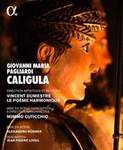|
Back
01/24/2019
Giovanni Maria Pagliardi: Caligula
Jan Van Elsacker (Caligula), Caroline Meng (Cesonia), Sophie Junker (Teosena), Florian Götz (Artabano/Domitio), Jean-François Lombard (Tigrane/Claudio), Serge Goubioud (Nesbo/Gelsa),
Le Poème Harmonique, Vincent Dumestre (conductor/theorbo),
Mimmo Cuticchio (marionette director/set co-designer), Alexandra Rübner (set co-designer), Patrick Naillet (lighting design)
Live recording: Tandem National Theatre, Arras, France (April 2017) – 80'
Alpha Classics 716 [1 Blu-ray disc] – Notes in French, English and German – Subtitles in English or French

   
Here is a Venetian opera from the 17th century performed by puppets. Mimmo Cuticchio, a master from the great Sicilian puppet tradition, is in charge.
Giovanni Maria Pagliardi (1637-1702) was born in Genoa. He had several works performed in Venice, the buzzing capital of popular opera, and also for aristocratic patrons in Florence, where he became the director of music for the cathedral. His Caligula (or Il Caligula delirante was presented in Venice in 1672 and then elsewhere in Italy. Delirante = delirious, the perfect word for what transpires.
Caligula, the impetuous Roman emperor, falls in love with Teosena, queen of Mauretania, whose husband, Tigrane, has been lost at sea. He commissions an artist to paint her portrait. This provokes the anger of the empress, Cesonia. Artabano, king of the Pythians, also falls in love with Teosena. (And the artist is his slave.) Cesonia gives Caligula a potion. I’m not sure if this causes his delirium, but in his madness he even pledges love to his elderly nurse, the stock comic servant we find in Venetian operas. Thanks to puppetry, he actually loses his head, as his normal head flies off and a demented-looking one replaces it. Caligula is deposed and stabs himself, apparently fatally. Two major turnabouts occur, however, giving a double happy ending: Caligula is abruptly restored to life (and sanity), and he is reunited with Cesonia. And the artist turns out to be the missing king, Tigrane, now restored to the faithful Teosena (who earlier didn’t even recognize him.)
According to the notes, Pagliardi’s score sat unknown for 350 years in Venice’s Biblioteca Marciana. The edition used for the puppetry performance has been shortened. As a result, some of the action moves along abruptly, but this adds to the knockabout entertainment value.
The music pulsates sensuously and is in very good hands with the six-member Le Poème Harmonique led by Vincent Dumestre who also plays the theorbo. Six singers voice the nine characters; tenor Serge Goubioud gets to sing the cynical nurse, Gelsa. They all have attractive voices and stylistic mastery, but outstanding is Caroline Meng as the spurned Cesonia.
The four puppeteers are in full view and are kept very busy at times. There are swordfights and a tiger makes an appearance (Caligula wants it to devour his unwanted wife.) Caligula’s self-disembowelment is a sight to behold. At times the camera shows the puppet and its singer, along with the puppeteer(s) with the instrumentalists placed tightly in front. Applause at the end reveals there was a live audience.
“Charming” is the term usually applied to puppetry. This certainly has charm, but the drama (when one accepts the conventions of the era) vividly comes through.
Michael Johnson
|